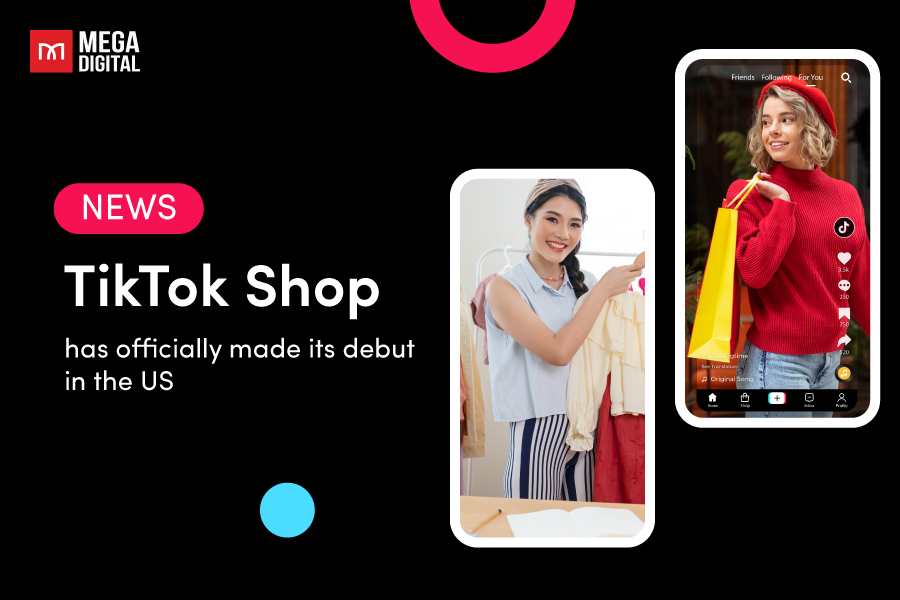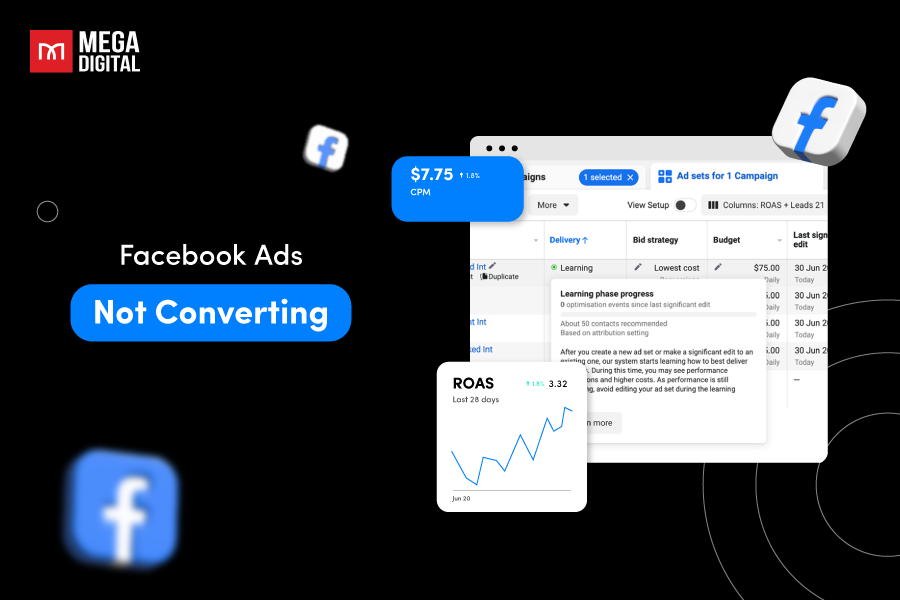You should reconsider your bidding strategy if you are struggling with low ad visibility, poor click-through rates, or high costs. Learn how to improve your Google Shopping bid strategy with Mega Digital’s guide on manual and performance-maximizing bidding methods, product type for better ad visibility, and click-through rates.
Understanding Bidding in Google Shopping
Bidding and Google Ads Auction relationship
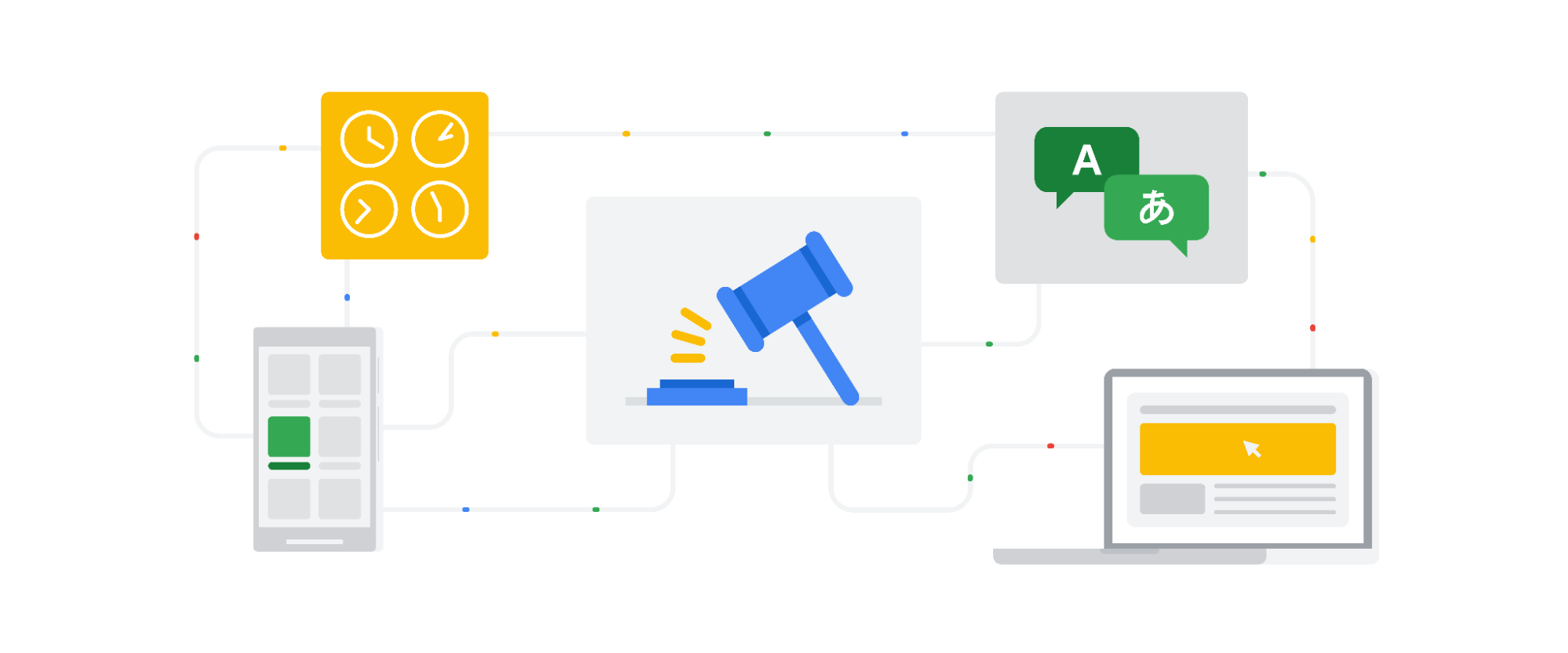
When someone searches on Google, it triggers an auction process to determine which ads will appear on the search results page. This auction system is based on the Pay-Per-Click (PPC) model, where advertisers only pay when someone clicks on their ad. Your Google Shopping bid strategy tells Google how much you are willing to pay for each click and how you want your ads to be shown. Bidding optimization involves adjusting your bids to get the most value for your advertising spend. Moreover, it helps your ad to win the auction and achieve your marketing goals.
For instance, if your objective is to drive more traffic to your website, you can use a maximize click bidding strategy to get as many clicks as possible. However, keep in mind that this approach may not necessarily result in high-quality traffic or conversions. Therefore, optimizing your bidding strategy to achieve your specific goals while maximizing the ROI of your Google Shopping campaigns is essential.
Factors affecting your Google Shopping bid strategy
To maximize the profitability of your Google Shopping campaign, it is important to understand how to determine your bids for each product. Consider these three key factors: Conversion rates (CR), product price, and gross margin.
Firstly, you should analyze your products’ conversion rates and invest more resources into high-converting products. This involves determining the average conversion rates for your products and adjusting your bids accordingly.
Secondly, you should consider the price of your products. Return on ad spend (ROAS) is largely determined by it, so it’s essential to take this into account when bidding.
Finally, gross margin is a crucial factor when determining your bids. You should bid higher for products with higher margins and lower for products with lower margins. This involves calculating basic cost margins for each product and categorizing them accordingly. Using the formula:

For example, you have two products with different CR, prices, and gross margins. Product A has a CR of 5%, a price of $50, and a gross margin of 60%. Product B has a CR of 3%, a price of $80, and a gross margin of 40%. Using the formula, the maximum bid for Product A would be $1.50, and for Product B, it would be $0.96.
How to set the perfect Google Shopping bid strategy
Google Shopping campaigns have two bidding strategies: Automated and manual.
Automated bidding tactics use Google’s machine learning and massive data resources to determine the bid amount. While this strategy might enhance sales and attract clients who would otherwise go unnoticed, it can also increase expenses because the algorithm must learn to determine the most efficient targeting.
We recommend a manual bidding strategy to guide the algorithm and focus on what works best for your campaign. This approach initially takes time to optimize the campaigns, but it can ultimately save money in the long run. Once enough data has been gathered; you can consider switching to an automated bidding strategy to increase efficiency and performance further.
Next, we will analyze each strategy in these two bidding strategies and give detailed examples of how you should use them.
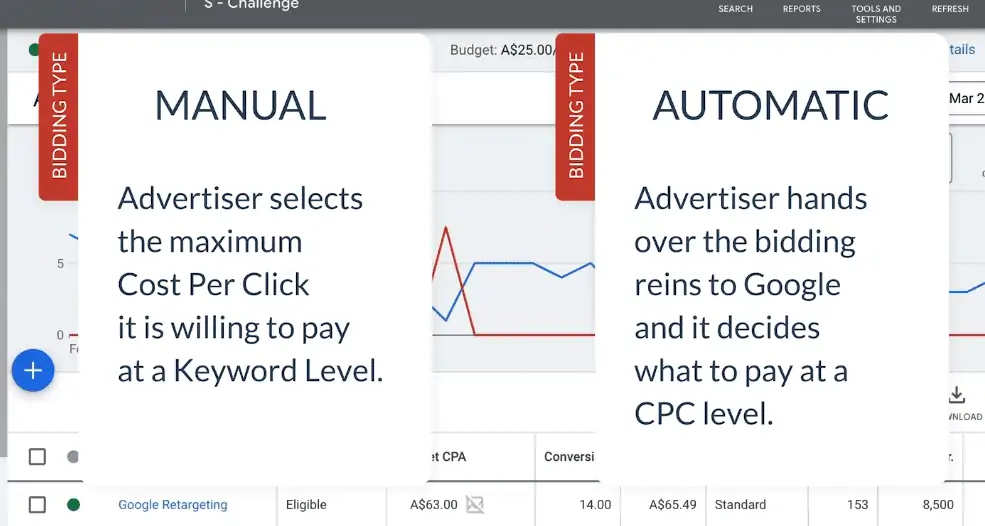
Strategy #1: Manual bidding (Standard Campaign)
Use manual bidding with Cost per Click (CPC) for an effective Google Shopping bidding strategy. Account for all campaign costs, segment products based on costs, and calculate revenue minus associated costs for clearer profit understanding. Consider various factors for successful management.
- Track trends in revenue and identify opportunities for reinvestment.
- Calculate the cost of goods to determine the profit a campaign generates accurately.
- Be strategic with ad spend, taking into account industry, business, and product variations.
- Monitor and optimize contribution margin to ensure maximum profitability.
Strategy #2: Automated bidding (Performance Max Campaign)
Maximize Clicks
Goal: Attract the most clicks for your budget
Where to apply: Campaigns and ad groups
The Maximize Clicks bidding strategy aims to get many clicks within your budget, but it may lead to cheaper clicks with lower conversion rates. Consider using it for brand awareness only after significant conversions. For Shopping campaigns, prioritize profitability and conversion value with strategies like Target ROAS or ECPC over Maximize Clicks.
Enhanced CPC
- Goal: Increase conversions while staying in control of your bids
- Where to apply: Campaigns and ad groups
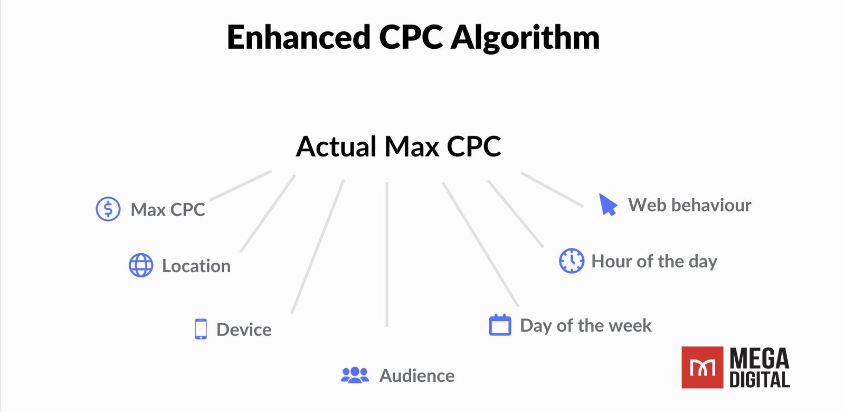
Enhanced cost-per-click (ECPC) is a bidding approach that allows you to boost conversions while maintaining control over your bids. To use ECPC, first enable conversion monitoring in your Google Ads account, allowing Google to track and improve your bids based on real conversion statistics.
After you’ve set up conversion tracking, you may apply ECPC to your campaigns or ad groups. Google will automatically modify your manual bids up or down based on the chance of each click. This means you may bid more aggressively on keywords or placements more likely to convert while lowering your prices on less useful traffic.
To utilize ECPC efficiently, you must evaluate campaign results and make appropriate bid modifications. You could also establish a maximum bid restriction to avoid exceeding your budget. You may wish to combine ECPC with other bidding techniques or targeting choices, such as audience targeting or ad timing. ECPC may be an effective bidding strategy for marketers looking to enhance conversions while keeping bid control.
Target ROAS
- Goals: Get the most conversions or conversion value while meeting a target ROAS
- Where to apply: Campaigns and ad groups.
Target ROAS Bidding is a Google Shopping Ads method that optimizes bids for maximum return on ad spend. Google adjusts bids to achieve a set target ROAS. It’s suitable for advertisers prioritizing profitability and requires sufficient conversion data for effective implementation.
Before implementing a Target ROAS Bidding strategy, it is recommended to start with a manual CPC strategy and gather around 50-100 conversions per month. This will allow Google to learn more about your customer base and optimize your bidding accordingly. Once you have enough data, you can switch to a Target ROAS Bidding strategy and set a realistic target ROAS. Setting an appropriate target ROAS because changing your goals can trigger Google’s learning phase.
Monitor your campaigns closely and make adjustments as needed. It is also important to track the performance of your campaigns and adjust your bidding strategy based on the results. By that, you can increase your return on ad spend and drive more sales and revenue for your business.
Conversion Value
- Goal: Get the maximum conversion value for a given budget
- Where to apply: Campaigns.
The Maximize Conversion Value bidding strategy aims to increase your total sales value by utilizing your conversion tracking and conversion data. This strategy is great to test out, but having historical conversion data in your account ensures that your conversion tracking is accurately set up. The goal is to maximize sales value rather than the number of customers, so it may not specifically focus on profitability.

To illustrate, suppose you sell luxury watches, and your goal is to maximize your sales revenue instead of just increasing the number of customers. In that case, you can use the Maximize Conversion Value bidding strategy to ensure that your ads are shown to users more likely to purchase with a higher order value.
However, this bidding strategy may only be suitable for some businesses, especially those prioritizing profitability over sales volume. As bidding experts, we recommend starting with manual CPC bidding. You can gradually test other bidding strategies like Target ROAS before experimenting with Maximize Conversion Value. This approach ensures you can fine-tune your bidding strategy and optimize it for your business’s unique needs.
Strategy #3: Product Group bidding
Brand
When running an e-commerce store selling branded products, allocating more budget to the Brand Product Group is important. This group typically attracts high-quality traffic, as shoppers who include the brand name in their search are further along the purchase funnel and more likely to convert as paying customers. By placing a higher bid for this Product Group, you can increase the chances of reaching these valuable shoppers.
Let’s say you run an e-commerce store selling various brands of athletic shoes, including Nike, Adidas, and Puma. You notice that your Nike shoes are particularly popular and have a higher conversion rate than other brands. To capitalize on this, you can create a separate Product Group for the Nike brand and allocate more budget to this group. Then set a higher bid for the Nike Product Group since you know that the traffic you get from this group is of higher quality and more likely to convert.
Category vs Product
Type Google’s categories may not be detailed enough for effective product segregation, so using Product Type instead is recommended. When deciding on bids, consider your Product Type’s Willingness To Pay (WTP). Generally, it’s best to reserve your ad budget for Product Types seen as luxuries, as shoppers are more willing to spend on them. For Product Types that fall into the bucket of daily necessities, it’s best not to go too crazy with your bids.
Custom Labels
Custom Labels allow you to subdivide your products in any way you want, which can significantly impact revenue growth. Some stores have increased revenue by over 100% by implementing Custom Labels. Popular Custom Labels include Pricing Groups, where you group products according to their prices and select a maximum cost-per-click (CPC) for each group. For example, a group of products priced below $99 might have a maximum CPC of $1, while groups with higher-priced products could have a higher CPC.
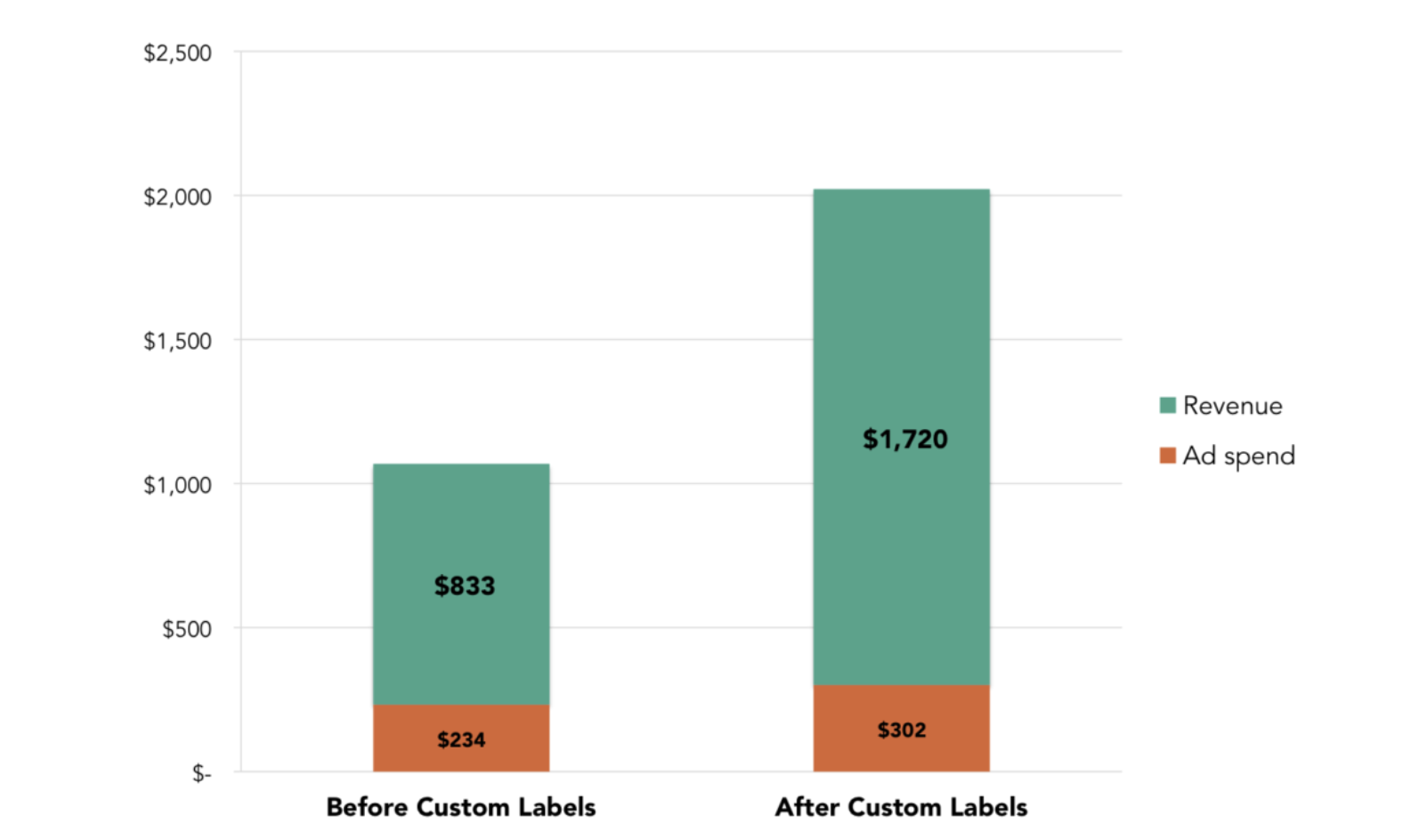
Some popular Custom Labels to consider for product grouping and bidding strategies include:
- Pricing Groups: Group products according to their price range and select a maximum cost per click (CPC) for each group. For instance, a group with products priced below $99 may have a max CPC of $1, while a group with products above $500 may have a max CPC of $5.
- ROI Groups: Group products according to their return on investment (ROI) or profit and bid accordingly. This ensures your campaigns are profitable, even for products with different price points.
- Seasonal Groups: Group products according to seasonality, such as back-to-school, Halloween, or Christmas. Adjust bids accordingly to capture increased demand during certain times of the year.

- Clearance/Sale Groups: Group clearance or sale items together and adjust bids accordingly. Increase bids to get rid of clearance items quickly or decrease bids to maximize profitability on regular-priced items.
- Performance Groups: Group best-selling items together and spend more on promoting them. Reduce bids for products that aren’t selling well or are being phased out.
Real-world examples of effective Google Shopping bid strategy
The Watch Co. is one of our Google Advertising service customers. We implemented a strategy of segmenting their campaigns based on performance and bidding accordingly. Analyzed the data and found that their branded products drove most of the sales, so we increased the bids. After that, we also decreased bids for products that weren’t performing as well. As a result, we saw a 108% increase in conversions and a 62% increase in revenue.
Additionally, we might have segmented the campaigns based on the intention of the shopper. Doing so could increase the chances of showing ads to potential customers more likely to convert while decreasing bids where ad spending was wasted. We regularly reviewed and adjusted the bids based on performance data. This would have helped us allocate ad spending more effectively and maximize the ROI.
As a top-tier Google partner, Mega Digital has a proven track record of helping thousands of clients achieve their desired conversions through our Shopping advertising and rental account services.
Best Practices for Google Shopping bid strategy
Segment your campaigns
You can create more targeted campaigns based on the intention of different segments. Understanding the search intent of your potential customers can help you avoid showing them irrelevant products. Moreover, your bid strategy also became more cost-effective. For instance, you can segment campaigns by product category or search queries.
Decrease bids for categories
Continuously monitor and optimize your campaigns to ensure you are not wasting ad spend on certain categories. If you notice a particular category is not performing well, decrease your bids and allocate that budget elsewhere. This can help improve your return on investment (ROI) and maximize your ad spend.
Plan bid increases
There are three converter descriptors: Mid-range, top, and one-off. Increase your bid when mid-range converters meet cost-of-sales goals. Use a bid-stacking strategy for top converters to increase profits. Establish a bidding strategy for one-off converters that balances exposure and spending.
Increase your bids during any promotion
Whenever you’re running a promotion, whether it’s a sale or a special offer, it’s essential to increase your bids. This ensures that your ads are more visible to potential customers. You can take advantage of the increased demand during these promotional periods, leading to higher sales and revenue.
Test your Google Shopping bid strategy
Finally, it’s essential to constantly test and adjust your bids to ensure that you’re getting the best possible ROI. This can involve testing different bid amounts, adjusting your bids based on performance data, or even testing different bidding strategies. Doing this ensures you always get the most out of your Google Shopping campaigns and maximize your profits.
>>> Read more: Optimize Google Shopping campaign with expert tips in 2023
END
In summary, taking advantage of your Google Shopping bid strategy is crucial for the success of your Google Shopping campaign. By choosing the right strategy, segmenting your campaigns based on customer intent, decreasing bids for wasteful ad spending, and planning when to increase bids, you can ensure your ads are displayed to the right audience at the right time.
As a leading Google partner, As Google partner, Mega Digital provides comprehensive support to businesses looking to make profits from Google platform.
>>> Read More: Best Google Ads Bidding Strategies and Pro Tips in 2023








